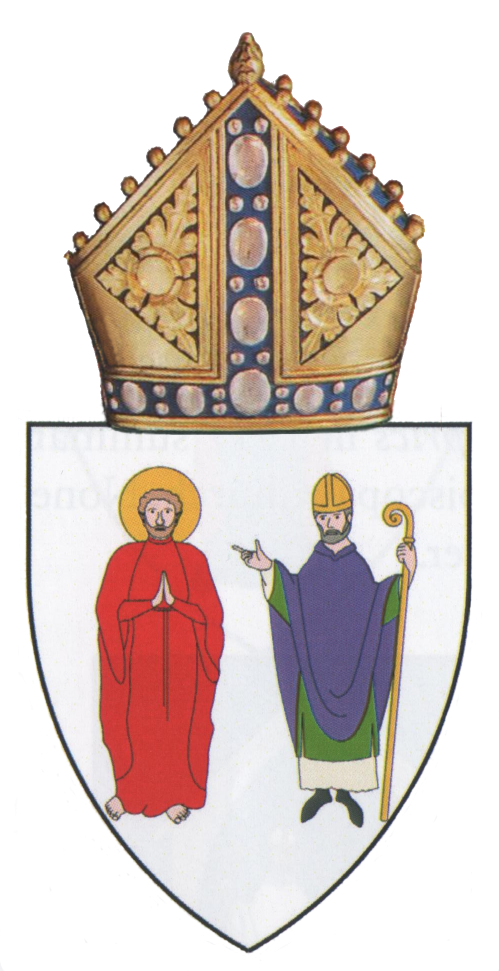
Foundation of
the Diocese of Ross
The lands of Ross extend from ocean to ocean - the German Ocean, or North Sea, in the east to the Atlantic Ocean in the west. These lands are usually considered in three parts - wester Ross, mid-Ross and easter Ross - since each area is considerably different from its neighbour. "
Easter Ross, between the Dornoch and Cromarty Firths, is distincly Lowland or even English in type. Its great alluvial plain, Machair Rois, the plain of Ross, comprises some of the richest agricultural land in Scotland. With it goes the large peninsula known as the Black Isle, between the Firths of Cromarty and Inverness, not level like the Machair, but sloping gently to both firths, and nowhere particularly Highland in aspect.
Mid-Ross may be said to extend from the western watershed to the uplands of Alness and Roskeen. It is a region of glens, straths, and streams, dominated by the massive bulk of Ben Wyvis.
Wester Ross is the long strip to the west of the watershed, between the latter and the sea, deeply indented by sea lochs and seldom far from sea influence. The great "hinterland" of Wester and Mid-Ross is wholly mountain and moor, with the exception of the beautiful valleys of the Kincardine Carron and its tributaries." [Watson (1865)]
Owing to the unexplained disappearance of the records of the Bishopric of Ross and the lack of other early sources of information, the date and manner of the foundation of the bishopric are both equally uncertain. It is known that the focus of Christian endeavour in this area was the Early Church community at Rosemarkie which may have existed as early as c.700AD. It is also thought that St. Duthac (d. 1065AD) may have served as a bishop in this area although his 'mission' was connected more with Tain and Dornoch rather than with Rosemarkie. But we should remember that in these early days bishops were itinerant in nature (episcopi vagantes) and did not have fixed catedrals or well-defined dioceses as such.
The first known bishop, Macbeth, appears as a witness to a charter granted by David I about the year 1125. Some consider that Macbeth, who was the last abb. of the Culdee Community at Rosemarkie, was translated by the saintly king to the new bishopric. The fact that, a century after the time of Macbeth, there were still only some half dozen canons, whose status was perhaps little more than nominal, suggests that in Macbeth's time, and later, the bishopric of Ross existed only in some minimal way. Macbeth is said to have described himself as "bishop of Rosemarkie" - perhaps the interpretation should have been "bishop at Rosemarkie", i.e. a rural or itinerant bishop who tended to be based at and, perhaps, lived most of the time within, the Culdee community at Rosemarkie. It was common practice for the bishop to be designated "of Rosemarkie" in the 12th-century, but thereafter usually "of Ross".
The Bishopric , at its inception, was co-extensive with the Earldom, and therefore it was only on the accession of Ferchar Mac-in-tagart, circ. 1220, that it came to include the churches of North Argyle. (vide infra)
The cathedral and its Chapter were moved from Rosemarkie to Fortrose c.1230-1260.
The medieval diocese was famously poor and often complained about its lack of funds. As a consequence, the cathedral at Fortrose was some time in building. We must remember that, as well as building the cathedral itself, funds had to be found to build manses and provide endowments to create prebends for the members of the chapter. Shortly after 1255/6, in an attempt to bolster its finances, the churches of 'North Argyll' were granted to the cathedral of Ross and they remained so annexed up to the time of the Reformation. These parishes were Kintail, Lochalsh, Lochcarron, Gairloch, Applecross and Lochbroom. The truth, however, is that Ross was not, perhaps, the poorest of the dioceses. About 1562 it ranked sixth out of the eleven dioceses - in order from the richest they were, St Andrews, Glasgow, Moray, Dunkeld, Aberdeen, Ross, Brechin, Orkney, Dunblane, Galloway and Caithness. When the Court of Session, the central civil court of the country, was endowed by King James V in the form of a College of Justice, it was created with Papal approval from ecclesiastical resources. The bishops were required to pay a sum which was, no doubt, proportional to the wealth of their diocese. Only the sums required from St Andrews (£70), Dunkeld (£42), Aberdeen (£28), Moray (£28), Galloway (£22 8s.), Ross (£16 16s.) and Caithness (£14) are reorded but even here we see that Ross was not the poorest.
It should be rememberd that although the diocese's name was Ross, and the bishop was usually known as Bishop of Ross, it was quite usual for the Dean and other dignitaries to bear the name of their original cathedral, e.g. 'Dean of Rosemarkie'. In the same way, in Moray diocese, where the bishop was known as the Bishop of Moray, it was quite common for the other dignitaries to bear the title 'of Elgin' or, more correctly 'of the Church of Elgin'. This situation often arises in Scotland where a number of the Dioceses' names are linked to geography whereas their cathedrals bear the names of the city where they were located - e.g. Moray Diocese but Elgin Cathedral, Ross Diocese but Rosemarkie (Fortrose) Cathedral, Caithness Diocese but Dornoch Cathedral. This is, of course, a quite different situation when compared to England where the names of the dioceses invariably reflect the name of the cathedral city. I believe that this is a reflection of the tribal nature of the Early Church in Scotland. Tied, as they were, to tribal lands of sometimes vast extent, it is only natural to find that, in times before cathedrals came into being and became fixed in one locus, the early bishops adopted the regional/tribal names. Even this, in the case of Moray, took some time and we have the interesting feature of a cathedra vagans, wandering between Birnie, Kinneddar and Spynie before eventually being settled in Elgin.
The title of this ancient diocese (of Ross) is still preserved in modern times: firstly in the name of the Scottish Episcopal Church's diocese of Moray, Ross and Caithness, and secondly in the name of a titular 'Bishop of Rosemarkie' (Rossmarkensis/Rossmarkaeum) which is still in current usage in the Roman Catholic Church. The arms shown at the top of this page are those which were matriculated and entered in the Lyon Register when it was first created in 1672. However, these arms, the first in Scotland used specifically for a diocese, are first noted in the seal of John Maxwell, Bishop of Ross (1633-38). Before this time, that is, throughout the medieval period, the bishops used their own personal or family arms, as can be seen in the many existing examples of episcopal seals and seal-matrices. The arms as matriculated depict: St. Peter and St. Boniface standing side by side, the former with nimbus and key in his right hand, the latter with mitre, right hand raised in benediction, left holding a crozier.
(The Diocese of Ross pages were last up-dated on 27/11/2024.)
e-mail: admin@cushnieent.com
